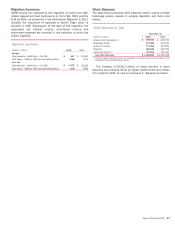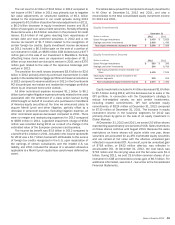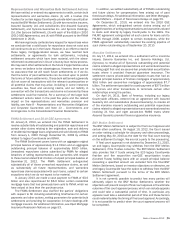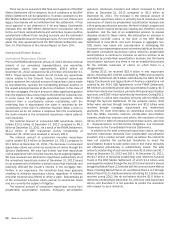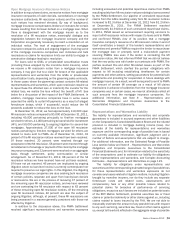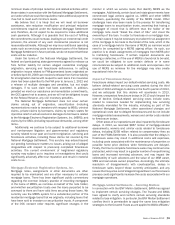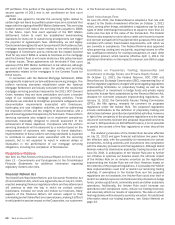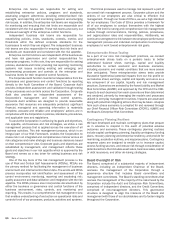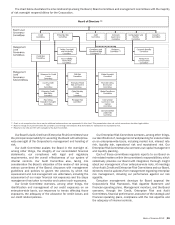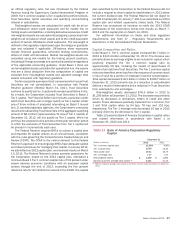Bank of America 2012 Annual Report Download - page 59
Download and view the complete annual report
Please find page 59 of the 2012 Bank of America annual report below. You can navigate through the pages in the report by either clicking on the pages listed below, or by using the keyword search tool below to find specific information within the annual report.Bank of America 2012 57
It is not possible at this time to reasonably estimate probable
future repurchase obligations with respect to those monolines with
whom we have limited repurchase experience and, therefore, no
representations and warranties liability has been recorded in
connection with these monolines, other than a liability for
repurchase claims where we have determined that there are valid
loan defects and determined that there is a breach of a
representation and warranty and that any other requirements for
repurchase have been met. Outside of the standard quality control
process that is an integral part of our loan origination process, we
do not generally review loan files until we receive a repurchase
claim, including with respect to monoline exposures. Our
estimated range of possible loss related to representations and
warranties exposures as of December 31, 2012 does not include
possible losses related to these monoline insurers. For additional
information, see Note 13 – Commitments and Contingencies to the
Consolidated Financial Statements.
Whole Loans and Private-label Securitizations
Legacy entities, and to a lesser extent Bank of America, sold loans
to investors as whole loans or via private-label securitizations. The
majority of the loans sold were included in private-label
securitizations, including third-party sponsored transactions. We
provided representations and warranties to the whole-loan
investors and these investors may retain those rights even when
the whole loans were aggregated with other collateral into private-
label securitizations sponsored by the whole-loan investors. The
loans sold with a total principal balance of $778.2 billion, included
in Table 12, were originated between 2004 and 2008, of which
$429.0 billion have been paid in full and $191.4 billion are
defaulted or severely delinquent at December 31, 2012. At least
25 payments have been made on approximately 64 percent of the
defaulted and severely delinquent loans. We have received
approximately $19.4 billion of representations and warranties
repurchase claims from whole-loan investors, including third-party
sponsors, and private-label securitization investors and trustees
related to these vintages, including $10.5 billion from private-label
securitization trustees, $8.0 billion from whole-loan investors and
$815 million from one private-label securitization counterparty. In
private-label securitizations, certain presentation thresholds need
to be met in order for investors to direct a trustee to assert
repurchase claims. Recent increases in new private-label claims
are primarily related to repurchase requests received from trustees
and third-party sponsors for private-label securitization
transactions not included in the BNY Mellon Settlement, including
claims related to first-lien third-party sponsored securitizations
that include monoline insurance. Over time, there has been an
increase in requests for loan files from certain private-label
securitization trustees, as well as requests for tolling agreements
to toll the applicable statutes of limitation relating to
representations and warranties repurchase claims, and we believe
it is likely that these requests will lead to an increase in repurchase
claims from private-label securitization trustees with standing to
bring such claims.
We have resolved $7.3 billion of the claims received from whole-
loan investors and private-label securitization investors and
trustees with losses of $1.6 billion. The majority of these resolved
claims were from third-party whole-loan investors. Approximately
$2.9 billion of these claims were resolved through repurchase or
indemnification and $4.4 billion were rescinded by the investor. At
December 31, 2012, for loans originated between 2004 and
2008, the notional amount of unresolved repurchase claims
submitted by private-label securitization trustees and whole-loan
investors was $12.2 billion. We have performed an initial review
with respect to $10.9 billion of these claims and do not believe a
valid basis for repurchase has been established by the claimant
and are still in the process of reviewing the remaining $1.3 billion
of these claims.
Certain whole-loan investors have engaged with us in a
consistent repurchase process and we have used that and other
experience to record a liability related to existing and future claims
from such counterparties. The BNY Mellon Settlement and
subsequent activity with certain counterparties led to the
determination that we had sufficient experience to record a liability
related to our exposure on certain private-label securitizations but
did not provide sufficient experience related to certain private-label
securitizations sponsored by third-party whole-loan investors. As
it relates to the other private-label securitizations sponsored by
third-party whole-loan investors and certain other whole loan sales,
it is not possible to determine whether a loss has occurred or is
probable; and therefore, no representations and warranties liability
has been recorded in connection with these transactions. Until we
receive a repurchase claim, we generally have not reviewed loan
files related to private-label securitizations sponsored by third-
party whole-loan investors (and are not required by the governing
documents to do so). Our estimated range of possible loss related
to representations and warranties exposures as of December 31,
2012 included possible losses related to these whole loan sales
and private-label securitizations sponsored by third-party whole-
loan investors.
Private-label securitization investors generally do not have the
contractual right to demand repurchase of loans directly or the
right to access loan files. We have received repurchase demands
totaling $1.6 billion from private-label securitization investors and
a master servicer where in each case we believe the claimant has
not satisfied the contractual thresholds to direct the securitization
trustee to take action and/or that the demands are otherwise
procedurally or substantively invalid.
Other Mortgage-related Matters
Servicing Matters and Foreclosure Processes
We service a large portion of the loans we or our subsidiaries have
securitized and also service loans on behalf of third-party
securitization vehicles and other investors. Our servicing
obligations are set forth in servicing agreements with the
applicable counterparty. These obligations may include, but are
not limited to, loan repurchase requirements in certain
circumstances, indemnifications, payment of fees, advances for
foreclosure costs that are not reimbursable, or responsibility for
losses in excess of guarantees for VA loans.
Servicing agreements with the GSEs generally provide the GSEs
with broader rights relative to the servicer than are found in
servicing agreements with private investors. For example, each
GSE typically claims the right to demand that the servicer
repurchase loans that breach the seller’s representations and
warranties made in connection with the initial sale of the loans
even if the servicer was not the seller. The GSEs claim that they
have the contractual right to demand indemnification or loan
repurchase for certain servicing breaches. In addition, the GSEs’
first-lien mortgage seller/servicer guides provide for timelines to
resolve delinquent loans through workout efforts or liquidation, if
necessary, and purport to require the imposition of compensatory
fees if those deadlines are not satisfied except for reasons beyond


